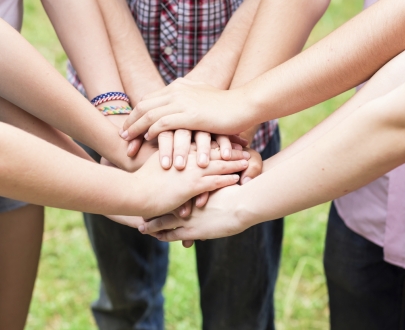
Created for youth by youth[1], the following activities were designed to develop Heart-Centered Leadership. They are fun, interactive activities and games that increase awareness and emphasize behaviours to: get along with others, be compassionate and kind, solve problems peacefully, be secure and calm, and remain alert and engaged.
Don’t forget to include the dialogue and reflection that follows each activity. This “lands the learning” and helps get students thinking about the importance of educating the heart and mind!
Activity 1: Group Agreements
Secure & Calm
SET IT UP: It is helpful to establish group agreements[2] before getting started with any of the activities to ensure that everyone will have and safe and enjoyable experience. This is particularly important when reflection and dialogue gets personal and/or addresses sensitive topics. If any agreements already exist - start by sharing these. For example, refer to the school’s code of conduct or a teacher’s ground rules.
EXERCISE: Generate a list of group agreements that are important to the youth participating. One example might be to avoid negative language and use empowering language instead. “I promise to respect others and listen while they talk!”
DEBRIEF: Ask the group; why do we need group agreements? How will we stay accountable to these rules?
 Activity 2: Mindfulness Effects
Activity 2: Mindfulness Effects
Solves Problems Peacefully
SET IT UP: Take a gauge of how students are feeling by asking them for a mood check-in. On a scale of 1-10 ask them to show how many fingers accurately describes their mood. 1 represents extreme comfort; 5 represents feeling content; 10 represents feeling extreme discomfort. Check in again, but this time have students show on their fingers their energy level[3]. 1 represents very tired and low energy; 10 represents feeling very energetic. Then introduce the concept of mindfulness. Mindfulness[4] requires you to pay attention, observe, describe, participate and focus on the present.
EXERCISE: Use a script[5] or try the Calm.com app which will give step-by-step instructions on how to engage in mindfulness. Ask students to sit up straight, get comfortable, not to disturb their neighbours, and close their eyes to listen before you begin the guided mindfulness activity.
DEBRIEF: Check-in with students by asking them to compare how they felt before the mindfulness activity to how they feel after. Talk about any differences and ideas of why they might feel different after this activity. Ask why it is important to be calm and brainstorm times and places that students might practice mindfulness?
 Activity 3: All in Good Order
Activity 3: All in Good Order
Gets Along with Others
SET IT UP: Split the group into two. Activate their thinking by explaining that everyone is different and these differences are what make us unique.
EXERCISE: Do this activity 4 times. For each round, ask students to form a line, without talking, according to:
-
Age
-
Height
-
Month of Birth
-
Number of siblings
DEBRIEF: What was challenging about this activity? What was easy? How did it feel not to be able to speak? How do we make sure that people’s differences are accepted?
 Activity 4: Compliments
Activity 4: Compliments
Compassionate and Kind
SET IT UP: Find a creative way to pair up students.
EXERCISE: Ask students to have a positive conversation with their partner for a full one minute. During this time, they should compliment each other and make comments on positive things they noticed about their partner.
DEBRIEF: At the end of one minute, debrief and discuss the activity. How did you feel about receiving a compliment? How did you feel about giving a compliment? Why is it important to embrace people’s positive traits? What happens when we only focus on negative traits?
 Activity 7: Unscramble the Quotes
Activity 7: Unscramble the Quotes
Alert and Engaged
SET IT UP: Split the group into teams of three students. Distribute the following quotes in a way that teams have to unscramble the words. Use a website to scramble the words[6] or write the words on cue cards and shuffle. Easy - give a list of all the quotes separately. Harder - scramble a few together!
EXERCISE: Quotes
-
Fall 7 times get up 8
-
Be the change you want to see
-
Don’t worry, be happy
-
Live as if you will die tomorrow, learn as if you will live forever
-
Float like a butterfly, sting like a bee
-
May the odds be ever in your favour
DEBRIEF: What made this game challenging/easy? What strategy did you use when working together? Who was the leader?
These activities were developed by students at John Oliver Secondary School in partnership with the South Vancouver Neighbourhood House.
Group agreements help to create safe and caring spaces that will enhance any group activity. They serve as a set of clear, co-created guidelines to help youth feel comfortable with each other in an atmosphere of safety, respect and trust.
Consider various elements when guiding a process to create group agreements.
Based on his research in adolescent medicine, Dr. Dzung Vo describes mindfulness as;
- being present
- awareness
- awakening
- concentration plus attention
- seeing clearly
- compassionate awareness
- openheartedness
- loving presence,
and connects living more mindfully with an increased ability to handle stress and experience more joy and gratitude.
The Mood Meter, developed at the Yale Center for Emotional Intelligence, is a tool to help students recognize emotions in themself and in others, understand the causes and consequences of a wide range of emotions, label emotions, express emotions in socially approriate ways and regulate emotions effectively (using the acronym RULER).
The Mood Meter has 2 scales, mood and energy. It can be more helpful in the development of self-awareness because sometimes people say they feel bad but in fact their mood is a "ok" but they are tired (low energy).
1. A sample mindfulness script.
2. A collection of mindfulness audio downloads.
Here is one example of an online word "scrambler."
